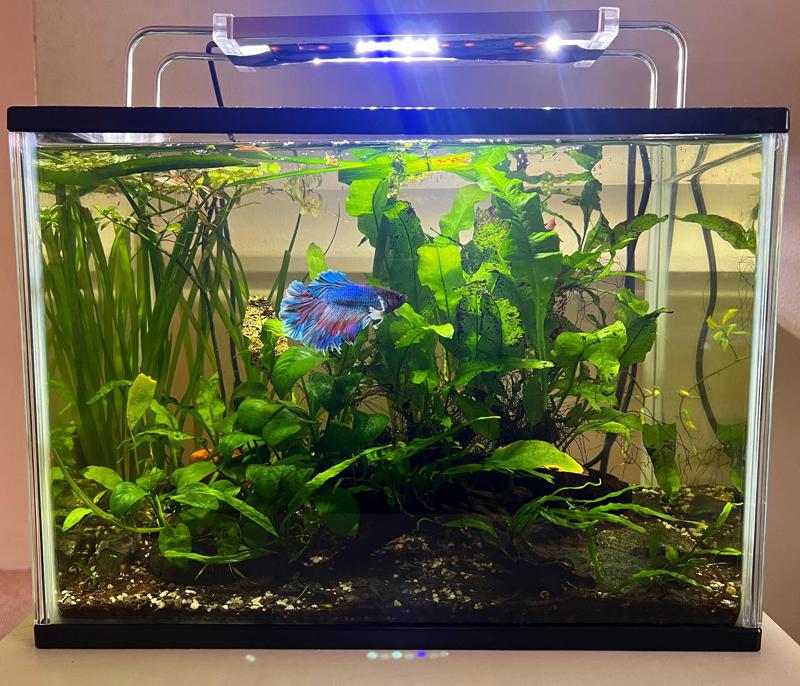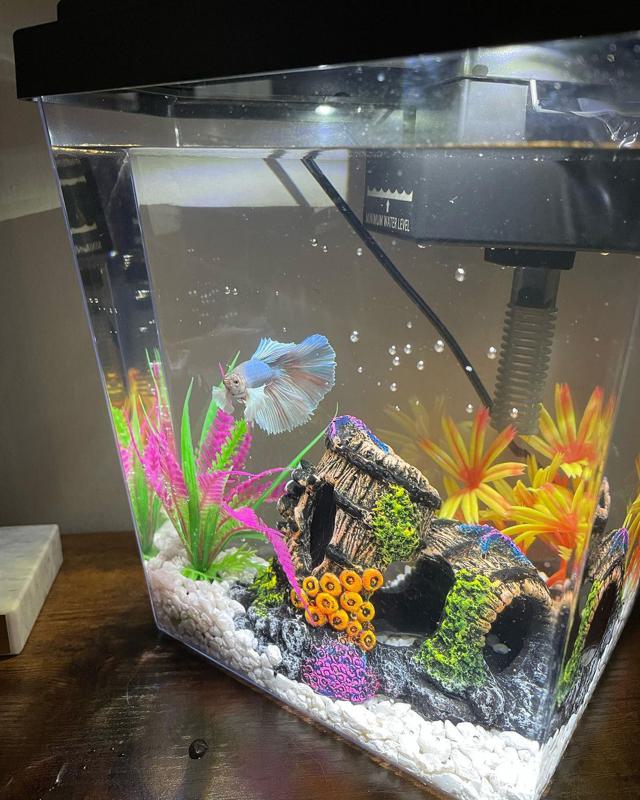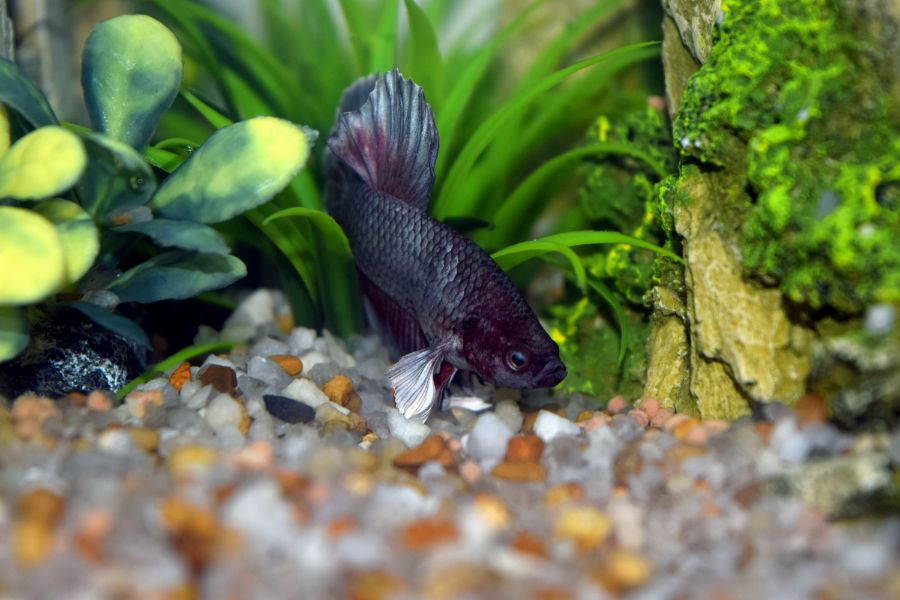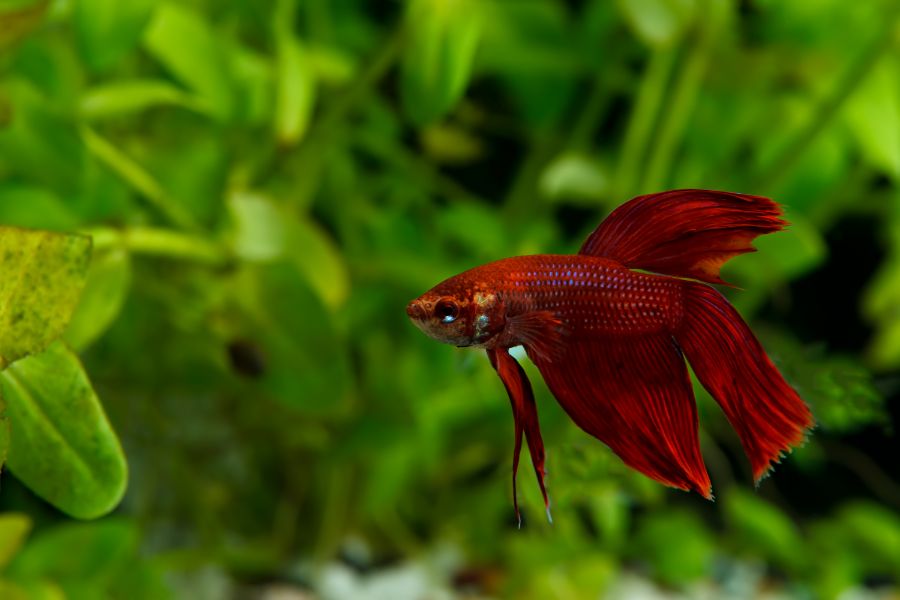Rocking mesmerizing colors, long flowing fins, and unique personalities, Betta Fish (also known as Siamese fighting fish) are perhaps the most popular choice for aquarium enthusiasts.
Bettas trace their origin back to the shallow waters of Cambodia, Thailand, and Vietnam. They stand out because they can survive in different environments. Because of this, some individuals think it’s a good idea to keep Bettas in small, decorative vases or bowls.
However, the beautiful water creatures deserve more than that. If you want your betta to thrive, it’s wise to provide your fish with plenty of space and filtered water. That means placing your betta in a tank.
But how do you set up a betta fish tank? Well, we are glad you found us. In this comprehensive guide, we will walk you through the steps of setting up your fish tank and creating a beautiful and comfortable home for your betta.
How to Set Up a Betta Tank
Setting up a betta tank might seem like a daunting task, especially if you are a novice fishkeeper or aquarist. But with a little knowledge and preparation, you will find this task fun and rewarding.
Bettas have a special organ – a labyrinth – that allows them to breathe the air above the water’s surface. Because of this unique ability, bettas can survive in warm and oxygen-poor habitats like shallow ponds, large rice paddies, and slow-moving streams.
This also explains why some individuals believe bettas can live in small bowls and flower vases.
However, bettas kept as pet require an environment that mimics or closely resemble their natural habitat. As such, pet owners must keep everything from temperature to diet consistent and natural for their fish.
With that in mind, let’s highlight a few accessories you should include in your betta fish tank to keep your fish happy and healthy.
Also Read: Best Betta Fish Tank Size
What To Put in Betta Fish Tank
Filter
Like most pet fish, Bettas require a filter in their tank. A filter will help keep the water in the tank clean. As a result, it helps prevent fungus, algae invasion, and bacteria in the aquarium.
The filter also plays an integral role in the nitrogen cycle, keeping the water in the aquarium free from toxins.
But remember, bettas naturally live in still waters. Their long, colorful fins make it difficult to swim in waters with strong currents. Therefore, pick a gentle filter for your betta tank. Alternatively, you can get a filter with adjustable flow settings.
Heater
Bettas originate from the tropical waters of Malaysia and Thailand. So, they require warm water to survive and stay healthy. These creatures thrive in waters with temperatures between 75 and 80°F.
A heater maintains a stable water temperature that is essential for your pet’s well-being. We recommend you get a submersible heater with a thermostat.
Always monitor the water temperature to ensure your betta stays healthy. Keep in mind that high water temperatures increase the aging rate of bettas and reduce their lifespan. On the other hand, low temperatures cause fish stress and make them susceptible to diseases like Ich.
You can use a different thermometer to observe the temperature changes since the ones attached to the heaters don’t always provide the most accurate details.
Substrate
Besides the heater, the betta tank needs the right substrate. Bettas can survive without substrate, but substrate can provide some additional benefits for the tank environment and serves several roles.
For instance, it creates breeding and colonizing grounds for bacteria essential for biological filtration. It also provides the fish a pleasant habitat (where it can burrow and hide) and reduces reflection within the aquarium that can stress your pet.
You can opt for fine gravel or sand substrate for your tank. Just ensure your substrate is designed for freshwater aquariums. Although some people prefer natural substrates, they could contain parasites and other unwanted organisms. If you opt for artificial gravel or substrate, ensure it’s free from toxins.
Plants and Decorations
In their natural habitat, bettas have plenty of hiding spots, which reduce stress, promoting healthy growth. To provide them with such an experience, you can add some plants and decorations to the tank.
Live plants help to improve the tank’s water quality by absorbing excess nutrients and providing oxygen. Additionally, they give your tank an aesthetic appeal, creating a pleasing environment for the fish and the observer.
If you opt for live plants, ensure the plant can survive under low light conditions and temperature. Some common betta tank plants include:
- Anubias – Anubias barteri, Anubias coffeefolia, Anubias nana petite
- Java Fern
- Marimo Moss Ball
- Amazon Sword
- Water Sprite
- Java Moss
- Anacharis
- Pennywort
As for fake water plants, we recommend you choose silky plants with no sharp edges. Betta fish have long, delicate fins that can easily get injured if they swim near objects with sharp or rough edges.
Lighting
Light is essential for fish since it helps to regulate their eating habits, energy level, and sleeping patterns. Unlike other fish, bettas prefer low-lighting conditions. A desk lamp or small LED light can provide the fish with sufficient light.
Water Conditioner/ Dechlorinator
A water conditioner or dechlorinator removes chlorine, chloramines, and heavy metals present in the tap water in the tank. These contaminants are usually toxic to fish and live plants and can cause several health problems if left untreated.
The conditioner establishes a clean and well-oxygenated environment for beneficial bacteria that maintain the overall tank’s health.
pH Adjusters
Like most freshwater fish, Bettas do well in water with a pH between 6.5 and 7.5. If the pH level of the water increases or reduces significantly, it can lead to several issues, like stress, disease, and sometimes death.
pH Adjusters are important in regulating the pH level in the tank. They can raise or lower the water’s pH, depending on your fish’s needs.
The two main types of pH adjusters include acidic and alkaline pH adjusters. An acidic adjuster lowers the pH level of the water, while an alkaline adjuster raises the pH level.
Step By Step Guide to Set Up Your Betta Fish Tank

Follow the steps below to set up your betta fish tank and ensure your friend stays happy and lives a healthy and long life.
1. Select Your Betta Fish Tank
We have already established that small, glass, or plastic bowls are not the most suitable home for bettas. So, shop for a sizable glass or clear acrylic fish tank. The larger, the better.
While a 2.5-gallon (9.5 liters) tank can do the trick, most aquarium experts recommend a 5-gallon tank for bettas.
A large tank will provide your fish with enough room to swim. It will also stay free from contaminants (fungus, bacteria, or algae) for longer than a small tank. In addition, you can effectively and safely heat the tank as well as establish a nitrogen cycle.
Another tip is that get a lid for the tank since bettas can jump out of the tank.
2. Determine Tank Position
After buying the tank, find the perfect location for it. Place the tank away from direct sunlight, but ensure it remains visible.
Too much sunlight tends to overstimulate bettas, causing them stress and agitation. Plus, it might affect their feeding habits. If you place the tank in a dark room or corner, your betta might lose its beautiful color.
Besides lighting, ensure the tank stays far from air vents and doors that lead to the outside, where there is a lot of cold and hot air flowing in. Also, avoid placing the tank near high-traffic areas, where pets and kids can bump into it.
It’s wise to place the tank near a power outlet and a water source. And get a stand to support the weight of a fish tank.
3. Add The Substrate
As for substrate, you can use either gravel or sand substrate for your betta tanks. Just ensure the gravel is small or smooth, so the fish doesn’t hurt itself when swimming at the bottom. Gravel comprising big, rough rocks allows food to hide in between, creating a good ground for bacteria growth.
Remove all traces of dust and dirt from the substrate by running it under water. Otherwise, they might clog the tank’s filter, leading to cloudy water.
Pile about 1 to 2 inches of substrate in the tank, especially if you plan to use live plants. If using artificial plants, 1 inch of substrate will suffice.
4. Install Filter
After finding the perfect place for your betta fish tank, leave about four to five inches between the tank and the wall to accommodate the filter.
Next, read through the manufacturer’s manual and set up your filter. Install the filter in a way that doesn’t create strong currents, then connect it to the external power. But do not turn on the power until you’ve filled the tank with water.
5. Set Up Plants and Decorations
Before adding live plants into the tank, wash them thoroughly to remove all contaminants. Next, bury their roots deep in the substrate to prevent them from coming loose. For the best view of your fish, arrange tall plants in the background and shorter ones in the front.
Position your decorations in the appropriate spots and anchor them properly in the gravel or substrate.
6. Fill The Tank with Water
The next step is to fill up the tank. Pour the tap water through a colander to avoid disturbing the substrate. Similarly, you can place a plastic bag or clean plate on top of the substrate and fill the tank.
Continue pouring the water into the tank until it’s one-third full. Check for leaks by placing the tank on a paper towel. In case of leaks, repair them immediately before filling up the tank. Lastly, remove the plastic bag or plate.
7. Add Water Conditioner and pH Adjusters
Add a few drops of water conditioner or de-chlorinator to the water to remove chlorine from the tap water. pH adjuster will remove any ammonia and nitrates in the tank and bring the water pH to 6.5 or 7, which is ideal for bettas.
8. Install Heater
Attach your preferred heater to the tank wall through its suction cups. Place it near the filter’s mouth to ensure the even distribution of heat throughout the water.
Once installed, plug in the heater, turn on the filter, and install the thermometer to observe the water’s temperature. Ensure the water temperature stays between 70 to 80 °F.
9. Add Lighting
If your tank comes with no lighting, opt for a small LED light or desk lamp. These products will provide moderately low lighting that bettas love.
Even better, some LED lights offer you the option of controlling the light intensity or automatic timers. As a result, they save you the hassle of changing the lights manually.
Makes sure the lighting doesn’t affect the water temperature. If it affects the temperature, look for a better light source before introducing your betta.
Related: Do Betta Fish Need a Bubbler?
How to Put a Betta Fish in A Tank
Now that you have set up your tank, it’s time to introduce your betta. Here are a few steps to help you successfully place your fish in its new environment.
1. Buy The Betta Fish
Only bring a fish home when you have finished setting up its tank, and it’s ready for use. This way, your betta can transition to its new habitat immediately.
Another thing, when buying a betta, select a healthy one. If the betta has white dots, do not take him, no matter what the seller tells you. The dots signal an illness. Also, avoid betta with scales, fin, or eye deformities. A healthy betta swims normally and appears more active than others.
After identifying a healthy betta, buy the fish and bring it home. Remember, bettas are solitary creatures, especially males. Because of this, each fish requires its tank.
2. Acclimate The Fish to The New Aquarium
Before introducing the betta to the tank water, you need to properly acclimate the betta to your home aquarium. If you follow the correct acclimatization process, you will provide your fish with the best chance of survival.
First, open the bag and add ½ cup of tank water into the bag. Wait for 15 minutes and add another ½ cup until the betta acclimatizes to the change in temperature, oxygen content, and water chemistry.
Other people like floating the bag containing the fish for 15 minutes to 1 hour. This allows the water in the bag to adjust to the temperature or the tank water.
3. Release the Betta into The Tank
Once the betta has adjusted to the tank environment, carefully take out the fish from the bag. Use a net to remove it from the bag and place it into the tank carefully. Ensure its long fins do not get caught in the netting.
Warning: Avoid releasing the water in the bag into the tanks, as it might contain parasites and diseases which can get transferred to the new beautiful tank habitat.
4. Feeding
Wait for about an hour before feeding the bettas, because they may feel stressed or uninterested in food after the move. After an hour, you can provide him with a variety of high-quality betta food, including live foods, pellets, or frozen treats.
Feed your betta once or twice a day, but avoid overfeeding him because he can become bloated. Also, avoid freeze-dried food, as they offer no nutritional value and can cause bloating.
5. Observe Your Betta
Monitor your betta for the first couple of days to ensure he’s adjusting well to his new home. Look for signs and symptoms of stress, like loss of appetite, crushing at the bottom of the tank, rubbing on gravel, rapid breathing, or lethargy.
What Do Betta Fish Like in Their Tank?

There are a variety of things bettas love in their tank, including:
- Heated tanks: These fish love swimming in warm waters with temperatures ranging from 76 ° to 84°F. When the water temperature drops below 76 °F, bettas may become sluggish and susceptible to illness.
- A place to hide: Bettas prefer tanks with lots of decorations and plants (live and artificial) which provide them with enough cover to hide and feel more secure and comfortable in their home.
- Moderate Lighting: Bettas prefer low-to-moderate lighting that mimics their natural environment. Too much light might cause your fish stress. And if the light is extremely low, the fish might lose its color.
- Proper pH levels: Besides moderate lighting, bettas thrive in neutral to slightly acidic environments.
- Well-oxygenated water: While bettas do well in water with low oxygen levels, they still need oxygen to survive. So, ensure your tank water is clean and well-oxygenated.
- Natural-looking décor: Include rocks, wooden branches, and plants to create a natural-looking environment for your fish.
- A variety of foods: In the wild, bettas mainly eat plankton, crustaceans, and larva. But as pets, these fish enjoy a range of foods, including betta pellets or flakes and frozen and live food.
- Regular water changes: By changing the water regularly, you can ensure your friend lives in a clean and healthy environment.
5 Betta Tank Ideas
Below, you will discover a few ways to make your aquarium visually appealing and interesting for your betta.
- Natural Theme: You can create a natural theme that mimics the betta’s natural habitat using rocks, live plants, or driftwood. Cave decorations and floating logs also provide bettas with places to hide.
- Color-Changing LEDs and Clear Rocks: You can give your betta’s home an upgrade by installing color-changing LEDs. These lights coupled with multi-colored clear rocks will give the tank a high-classy party vibe. Take things a notch higher by adding a few live plants to give the aquarium a more natural feel.
- Themed Tank: Are you fun of castles or pirate ships? Well, you can bring such themes to life by using several carefully selected decorations and accessories.
- Vegetation Variety: Use a variety of plants to create a jungle-like atmosphere for your betta. Remember, these fish love exploring the soft covers of live plants.
- Aquscaping: Utilize the principles of aquascaping to hide the filter, heater and pipes, and improve the tank’s aesthetics using a variety of plants and decorations.
While it’s important to make your betta tank visually appealing, ensure the home provides your betta with the best conditions to stay healthy and live for a long time.
Related:
- Do Betta Fish Need Air Pumps?
- Do Betta Fish Eat Other Fish?
- Can Betta Fish Live Together?
- How Long Can Betta Fish Go Without Food?
- How Often & How Much To Feed Betta Fish?
- What Kind of Water Do Betta Fish Need
Conclusion
As we wrap up, the betta fish tank setup might seem like a difficult and time-consuming project, but it can be exciting and fulfilling. All you have to do is follow the outlined steps to create a beautiful and comfortable environment for your betta.
Also, check out our betta tank ideas to improve your tank’s visual appeal and make it interesting to your freshwater friend.
But remember, it’s crucial to maintain your betta tank regularly to ensure your fish stay healthy and happy. By taking care of your fish and its environment, you can enjoy many years of friendship.
If you need further clarification on something, leave us a message in the comment section.

